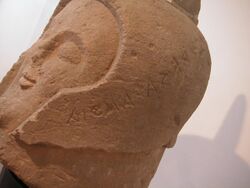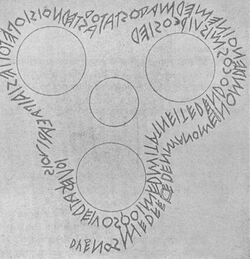Social:Old Italic script
| Old Italic | |
|---|---|
The Marsiliana tablet abecedarium, ca. 700 BC: ABGDEVZHΘIKLMNΞOPŚQRSTUXΦΨ, read right to left | |
| Type | Alphabet
|
| Languages | Italic languages, Etruscan, Raetic, Venetic, Lepontic, Messapic |
Time period | 8th to 1st centuries BC |
Parent systems | Egyptian hieroglyphs
|
Child systems | Latin alphabet, Runic alphabet |
Sister systems | Anatolian alphabets |
| Direction | Left-to-right |
| ISO 15924 | Ital, 210 |
Unicode alias | Old Italic |
| U+10300–U+1032F | |
Old Italic is one of several now extinct alphabet systems used on the Italian Peninsula in ancient times for various Indo-European languages (predominantly Italic) and non-Indo-European (e.g. Etruscan) languages. The alphabets derive from the Euboean Greek Cumaean alphabet, used at Ischia and Cumae in the Bay of Naples in the eighth century BC.
Various Indo-European languages belonging to the Italic branch (Faliscan and members of the Sabellian group, including Oscan, Umbrian, and South Picene, and other Indo-European branches such as Celtic, Venetic and Messapic) originally used the alphabet. Faliscan, Oscan, Umbrian, North Picene, and South Picene all derive from an Etruscan form of the alphabet.[citation needed]
The Germanic runic alphabet may have been derived from one of these alphabets by the 2nd century AD.
Alphabets
Etruscan alphabet
It is not clear whether the process of adaptation from the Greek alphabet took place in Italy from the first colony of Greeks, the city of Cumae, or in Greece or Asia Minor. It was in any case a Western Greek alphabet. In the alphabets of the West, X had the sound value [ks], Ψ stood for [kʰ]; in Etruscan: X = [s], Ψ = [kʰ] or [kχ] (Rix 202–209).
The earliest Etruscan abecedarium, the Marsiliana (near Grosseto) tablet which dates to c. 700 BC, lists 26 letters corresponding to contemporary forms of the Greek alphabet which retained Digamma, san and qoppa but which had not yet developed omega.
Until about 600 BC, the archaic form of the Etruscan alphabet remained practically unchanged, and the direction of writing was free. From the 6th century, however, the alphabet evolved, adjusting to the phonology of the Etruscan language, and letters representing phonemes nonexistent in Etruscan were dropped. By 400 BC, it appears that all of Etruria was using the classical Etruscan alphabet of 20 letters, mostly written from left to right:
An additional sign Template:Script/Old Italic, in shape similar to the numeral 8, transcribed as F, was present in both Lydian and Etruscan (Jensen 513). Its origin is disputed; it may have been an altered B or H or an ex novo creation (Rix 202). Its sound value was /f/ and it replaced the Etruscan FH. Some letters were, on the other hand, falling out of use. Etruscan did not have any voiced stops, for which B, C, D were originally intended (/b/, /g/, and /d/ respectively). The B and D therefore fell out of use, and the C, which is simpler and easier to write than K, was adopted to write /k/, mostly displacing K itself. Likewise, since Etruscan had no /o/ vowel sound, O disappeared and was replaced by U. In the course of its simplification, the redundant letters showed some tendency towards a semi-syllabary: C, K and Q were predominantly used in the contexts CE, KA, QU.
This classical alphabet remained in use until the 2nd century BC when it began to be influenced by the rise of the Latin alphabet. The Romans, who did have voiced stops in their language, revived B and D for /b/ and /d/, and used C for both /k/ and /g/, until they invented a separate letter G to distinguish the two sounds. Soon after, the Etruscan language itself became extinct.
Oscan alphabet
The Osci probably adopted the archaic Etruscan alphabet during the 7th century BC, but a recognizably Oscan variant of the alphabet is attested only from the 5th century BC; its sign inventory extended over the classical Etruscan alphabet by the introduction of lowered variants of I and U, transcribed as Í and Ú. Ú came to be used to represent Oscan /o/, while U was used for /u/ as well as historical long */oː/, which had undergone a sound shift in Oscan to become ~[uː].
Alphabet of Nuceria
The Nucerian alphabet is based on inscriptions found in southern Italy (Nocera Superiore, Sorrento, Vico Equense and other places). It is attested only between the 6th and the 5th century BC. The most important sign is the /S/, shaped like a fir tree, and possibly a derivation from the Phoenician alphabet.
Alphabet of Lugano
The Alphabet of Lugano, based on inscriptions found in northern Italy and Canton Ticino, was used to record Lepontic inscriptions, among the oldest testimonies of any Celtic language, in use from the 7th to the 5th centuries BC. The alphabet has 18 letters, derived from the archaic Etruscan alphabet:
The alphabet does not distinguish voiced and unvoiced occlusives, i.e. P represents /b/ or /p/, T is for /t/ or /d/, K for /g/ or /k/. Z is probably for /ts/. U /u/ and V /w/ are distinguished. Θ is probably for /t/ and X for /g/. There are claims of a related script discovered in Glozel.
Raetic alphabets
The alphabet of Sanzeno (also, of Bolzano), about 100 Raetic inscriptions.
The alphabet of Magrè (near Schio), east Raetian inscriptions.
Venetic alphabet
Alphabet of Este: Similar but not identical to that of Magrè, Venetic inscriptions.
Camunic alphabet
Inscribed abecedarium on rock engraves in Valle Camonica.
Latin alphabet
21 of the 26 archaic Etruscan letters were adopted for Old Latin from the 7th century BC, either directly from the Cumae alphabet, or via archaic Etruscan forms, compared to the classical Etruscan alphabet retaining B, D, K, O, Q, X but dropping Θ, Ś, Φ, Ψ, and F. (Etruscan U is Latin V; Etruscan V is Latin F.)
South Picene alphabet
The South Picene alphabet, known from the 6th century BC, is most like the southern Etruscan alphabet in that it uses Q for /k/ and K for /g/. It is:
⟨.⟩ is a reduced ⟨o⟩ and ⟨:⟩ is a reduced ⟨8⟩, used for /f/.[2]
Unicode
The Old Italic alphabets were unified and added to the Unicode Standard in March, 2001 with the release of version 3.1.
Block
The Unicode block for Old Italic is U+10300–U+1032F without specification of a particular alphabet (i.e. the Old Italic alphabets are considered equivalent, and the font used will determine the variant).
Writing direction (right-to-left, left-to-right, or boustrophedon) varies based on the language and even the time period. For simplicity most scholars use left-to-right and this is the Unicode default direction for the Old Italic block. For this reason, the glyphs in the code chart are shown with left-to-right orientation.
Letters with Transliteration
See also
- Euboean alphabet
- Negau helmet
- Alphabets of Asia Minor
References
- ↑ 1.0 1.1 Ager, Simon (1998–2018). "Etruscan alphabet". Omniglot. http://www.omniglot.com/writing/etruscan.htm.
- ↑ Stuart-Smith, Jane (2004). Phonetics and philology: sound change in Italic. Oxford: Oxford University Press.
Further reading
- Bonfante, Giuliano and Larissa Bonfante. The Etruscan Language: An Introduction. Manchester: Manchester University Press, 2002.
- Mullen, Alex. Southern Gaul and the Mediterranean: Multilingualism and Multiple Identities in the Iron Age and Roman Periods. Cambridge: Cambridge University Press, 2013.
External links
| Wikimedia Commons has media related to Italic letters. |
| Wikimedia Commons has media related to Etruscan alphabet. |
| Library resources about Old Italic script |
- Etruscan Texts Project: A searchable online database of Etruscan inscriptions.
- Old Italic Unicode
- The Etruscan alphabet (Omniglot)
- Old Italic alphabets (Omniglot)
- Etruscan (Ancient Scripts)
- Oscan (Ancient Scripts)
- Unicode Fonts
it:Lingua etrusca#Alfabeto






